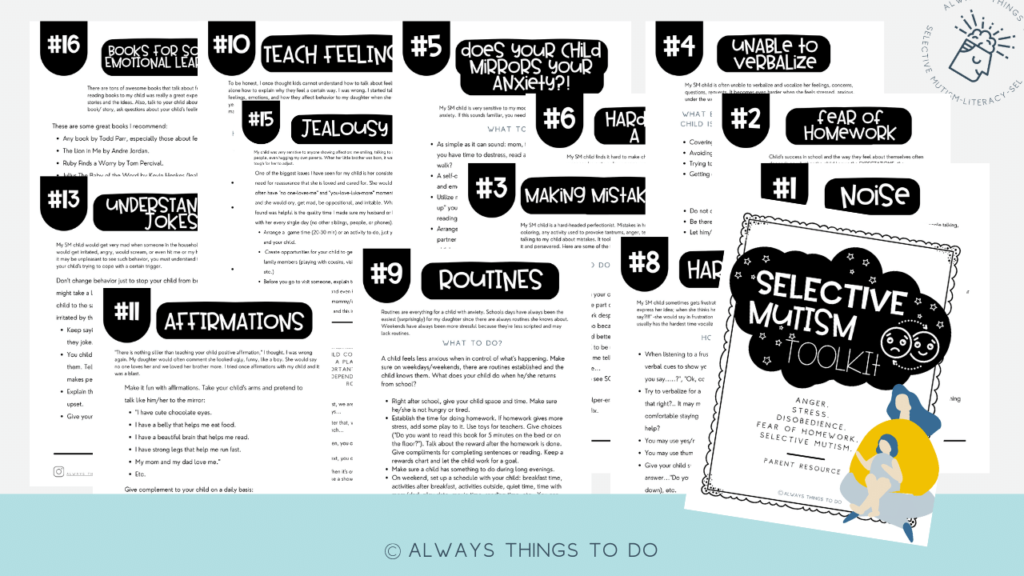Selective Mutism Tantrums: How to Deal With a Ball of Anger After School.
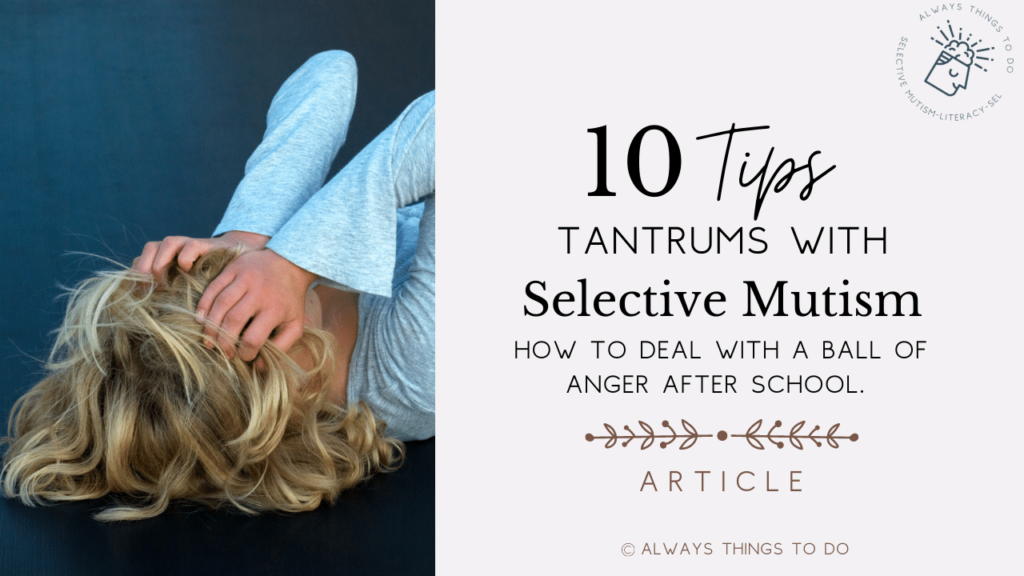
In this post, you will find out how to help your child with selective mutism who has bad tantrums after school or any activities.
Before my child was diagnosed, I surely thought my daughter’s selective mutism tantrums were due to my failure as a parent. It felt horrible.
Not being able to understand the reasons would push me into self-blaming and resentment towards my child.
The bad news about selective mutism tantrums is that they linger for some time even with therapy and medication in place. The good news is that tantrums can become more manageable and preventable in most cases.
Even though there can be dozens of triggers that cause tantrums with selective mutism, the ability to prevent and be ready for tantrums will depend on how well you know your child, his/her patterns of behavior, and worst triggers.
What Triggers Selective Mutism Tantrums?
Selective mutism is rooted in anxiety which manifests in different selective mutism behaviors and conditions. Read “70 Selective Mutism Symptoms & 3 Diagnostic Criteria” to find out whether your child also displays some of these behaviors.
A lot of the typical behaviors, like anger outbursts from 0 to 100, anger when questioned by parents, domineering attitude at home, clinginess, bossiness, disobedience, “drama moments”, even hitting a parent or a sibling are caused by the stimuli and situations a child encounters outside in the environment that triggers certain reactions.
Most common to all kids with selective mutism inability to verbalize in social settings and with some adults is the biggest trigger. Unable to communicate and “isolated” in terms of communication possibilities, a child with selective mutism is unable to satisfy his/her communicative and socialization needs that are so natural for any child.
In addition, a child is bombarded with a variety of stimuli from the environment that a child can’t always process appropriately. Together with the inability to communicate, these stimuli create a “perfect storm” that translates into after-school tantrums a child with selective mutism often has.
How To Help A Child With Selective Mutism During Meltdowns.
The best place to start when trying to deal with selective mutism tantrums is for a parent to understand that the tantrums are reactions to stimuli and situations that a child has a hard time processing.
Tantrums are a child’s inability to regulate emotions and the overwhelm the child experiences from the incapacity to self-express, communicate, process multiple triggers.
An ability to deal with tantrums for a parent starts with an understanding that a tantrum is a reaction to something that happened previously, and it’s NOT just disobedience or bad behavior.
Also, parents’ capacity to help will depend on their own emotional state.
Here are some things a parent of a child with selective mutism can do to help avoid or deal with tantrums:
Selective Mutism Tantrums Tip #1: Learn to predict tantrums before they start.
Before any other reason, a child with selective mutism will be triggered by hunger and tiredness. The reason why tantrums always happen after school is that a child is most likely very tired (physically and emotionally) and hungry. This is also true for any place and any time.
- One of the things that helped me to prevent my child’s after-school tantrum or make it “milder” is to talk to her about the things that are ahead when I would pick her up after school. I would lay out the “after-school-time” schedule, making sure there are some fun things for a child.
For example, coming home – playing with toys – eating – watching a movie – sweet snack – homework – shower time – building a fort – movie time before bed. Any of the routines that work for your child presented ahead and creating predictability will soothe the sharpness of after-school selective mutism tantrums or help avoid them.
- Another tip that I used to use a lot with my daughter is to bring something new in the car when I pick her up from school.
It can be a new toy, set of pencils, coloring book, etc. The novelty of the object would distract my daughter from her negative thoughts and allow me to transition her more affectively to the routine at home, after school.
- Tantrums don’t always happen just after school. They also happen after a holiday celebration, guests, trip or any event that is different from a daily predictable routine.
To deal with those means trying to keep some predictability and a set of routines that can work for weekends or holidays. Self-made schedules with pictures or just telling the child about the day will help them focus on things that are coming and avoid anxiety around unpredictable events.
Selective Mutism Tantrums Tip #2: Understand the top 7 triggers and be ready to mediate.
From my family’s experience of dealing with selective mutism of our daughter and after-school tantrums, I can clearly name 7 top triggers that I have learned to predict and handle.
- Events at school and inability to talk about it even at home.
Mute at school, a child experiences enormous pressure at school. The mist of fear, anxiety, frustration, unsatisfied needs will result in a tantrum after school.
Advice: Try to lower the severity of the tantrums by following tip #1. Allow a child to feel anger. Tell him/her, “It’s OK to feel angry or mad. I also feel angry sometimes. Do you want me to stay with you or do you want to play with your toys for now?”
2. A child being bored.
Advice: a child with selective mutism craves predictability and routines. Having some sort of daily routine can help avoid boredom. Offer novelty by doing the same routines in a different way (reading under the bed with a flashlight, doing homework on the floor, going to a different park, etc.).
3. Hunger and tiredness.
Advice: make sure you always have snacks before or after some events, going out.
4. Being in an environment with too many stimuli to process (ex.: a TV on in the living room, parents talking in the kitchen, a little brother racking havoc, too many toys on the floor, etc.)
Advice: Make sure you regulate the environment in your house. Set up a place for a child to go to if he/she feels irritated by the noise. (For example, you can build a house out of cardboard, put some lights, pillows, toys. It can also be a place under the bed or a table that a child can make his/her own.) Teach the child the routine of what to do when he/she feels uncomfortable due to the environment (noise, light, people).
5. A child having no personal safe space.
Advice: A child needs to have his/her own personal space where no one can see him/her. My daughter used to have her cardboard house where she would go when she feels irritated or mad. When she grew, she would hand out under her bed with pillows, toys, and iPad.
Set up the place that belongs only to the child (under the bed, someplace in the bedroom, toy house, etc.). Teach the routine of going to the “safe place” when the child feels irritated.
6. Lack of quality time with the child.
Advice: Be present with your child not only in difficult times (moodiness, tantrums, etc.) but in great moment too. Spend 10-15 minutes (I know how busy it can be) of quality time with the child every day. Do together something a child wants (movie night with an iPad, making cupcakes, reading, playing toys).
7. Homework.
Homework can be a huge stressor. If a child struggles academically, homework-related stress is enormous.
Advice: “Selective Mutism Home-School Parent Toolkit” has an amazing resource called “How to help an angry child.” There I share my advice about the homework problems. ⬇️⬇️⬇️
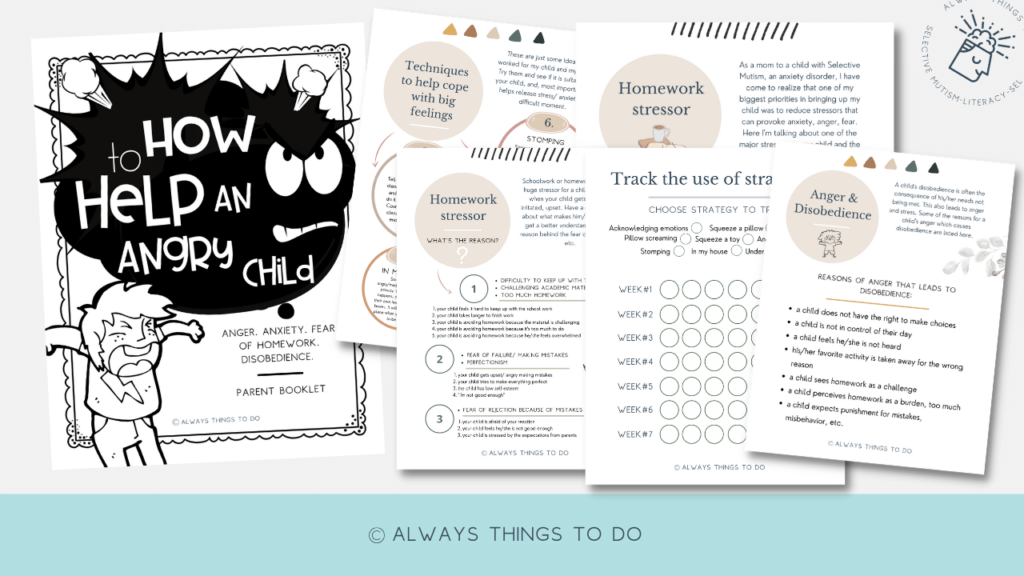
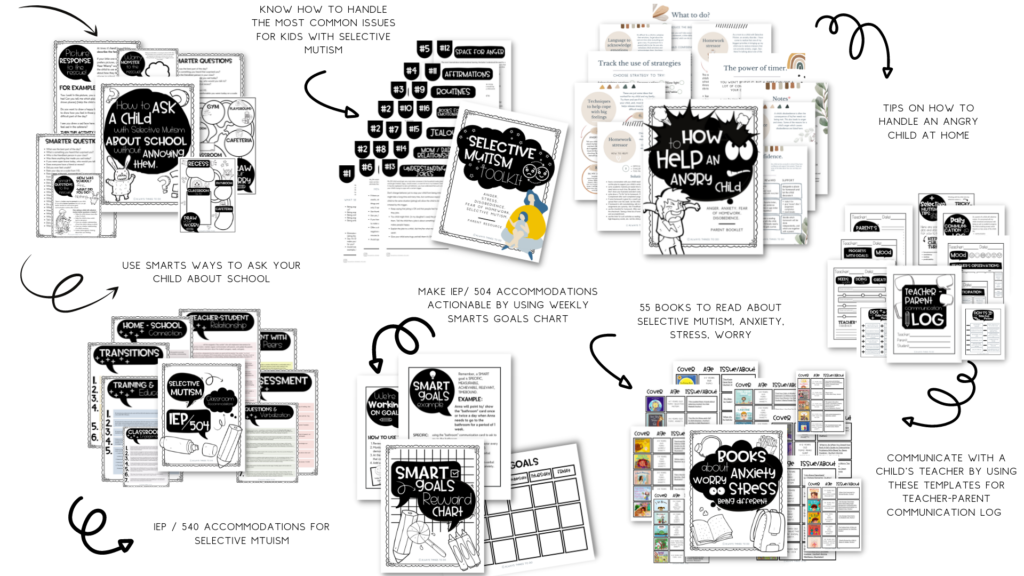
Selective Mutism Tantrums Tip #3: Create a child’s space where a child can feel safe.
A child’s safe place is not only the place he/she can be in situations of tantrums, irritability, sadness. It’s most importantly the place where parents are able to meet the emotional rollercoaster with understanding and energy to support and accept without judging.
It is hard to stay sane or even untouched by tantrums of a child with selective mutism because at times the moodiness and anger seem to be never changing. I know it because I have been there, too.
However, what I have come to realize is that my inability to be calm and composed when my child has a meltdown will only fuel more screaming and anger.
It took me 2 years of learning, but I’m much closer to being a mom who is OK with screaming and hitting because I understand where it comes from. I also developed tools that I have been using for more than two years to help my child in situations when emotions are strong and screaming seems to be overwhelming.
Explore the 2 resources in the “Selective Mutism Home-School Parent Toolkit”:
- How to help an angry child.
- Selective Mutism Tookit: 15 most common issues of children with selective mutism. ⬇️

Selective Mutism Tantrums Tip #4: Acknowledge their anger and verbalize it for them.
In times of big emotions, a child with selective mutism needs acknowledgment of his/her anger and frustration.
Use such words as “I see you are frustrated/angry/mad/ scared. It’s OK to be frustrated/angry/mad/ scared. Do you want to squeeze your pillow or lie under the bed with your favorite toy.”
Verbalizing emotions is a key. A child needs to know you understand what’s happening. Verbalizing emotions will give a child keys to expressing themselves when they grow older. It’s a great emotional intelligence skill.
At times, talking will not help. And that’s OK.
My daughter often would be so defiant and angry that nothing would help. In those times, I would just give her so to say “space for anger.” After 10-15 minutes alone or in her room, she would still be angry but would allow me to stay with her. As I continue talking to her about how she felt and acknowledging it, she would slowly change from anger to sadness. Sadness is easier to work with.
The bottom line, verbalize emotions for a child, offer them options of what can be done to feel better (toy, snack, hanging out under bed with a toy, etc.), or (if nothing really helps) give them space for anger.
Selective Mutism Tantrums Tip #5: Teach a child to verbalize emotions (long-term).
When your child is still little (3-4-5 years old), do not expect this strategy to give results quickly. Verbalizing emotions will be your job in times of tantrums and anger. However, the continuous habit of talking about emotions and expressing them in an acceptable way will give results later when your child grows up (6-7 years old).
Advice: “Selective Mutism Home-School Parent Toolkit” has an amazing resource called “How to help an angry child.” There I share my advice about teaching emotions.
Selective Mutism Tantrums Tip #6: Stick to the routine and predictability.
Children with selective mutism experience anxiety that may come if they face the unknown, the new. That’s why creating routines and making sure there is predictability in how things run is so important not only for home but for school as well.
Routines come easier on weekdays.
It can be harder on weekends and during holiday breaks. Sticking to a familiar routine on weekends and holidays will help a child with selective mutism navigate unpredictability and anxiety more efficiently.
Check out the post about school days routines “Routines For School: How To Help a Reluctant & Anxious Child Thrive in Daily Routines and Reading.” Download the free “My Day Schedule” (description in the post).
Selective Mutism Tantrums Tip #7: Create a space for a child to be “busy”.
This can be done in many different ways. What worked for our family is having the things for my daughter in place and available when she needs to be busy and playing by herself:
- Rotating toys in the toy corner.
- Adding new toys from time to time.
- Having books available in the house. In our household, books are all over: on the floor, in baskets, on the shelves, even under the bed. Whenever my daughter would feel bored she would grab a book to look though or read independently or with me.
- Having paper and crayons.
- Sensory objects: playdough, moon sand, container with a little water, stickers, squishable.
One of the things that helped me to build my child’s independence in finding things to do when bored is I would rarely entertain her she complains about boredom.
I would ask her, instead to find something to do. After a few minutes of nagging and complaining, she would finally find herself occupied with the things available to her (see the list above).
Selective Mutism Tantrums Tip #8: Use a 10-miute “mommy/daddy-child” time.
Quality time is so important.
It is essential for a child with anxiety. When my daughter’s selective mutism was in the full swing, with complaining, nagging, mood swings, and anger being on a daily agenda, I would make sure we always have 10-15 minutes of mommy-daughter time.
We would watch a cartoon of her choice together, play barbies with the timer, color, read, etc. with no interruption from TV or phones.
This time has been so important because during this time you can try to give all your attention to an anxious, self-doubting child and find opportunities to show love and encouragement.
It may sound “not a big deal” or irrelevant, but I can say for sure that quality time with your child will dramatically shift the frequency and severity of tantrums.
Selective Mutism Tantrums Tip #9: Create opportunities for self-expression.
Inability to verbalize in most social settings deprives a child with selective mutism of many opportunities for self-expression: expression of ideas, interest, feelings, moods, thoughts, talents, etc.
Self-expression becomes essential for a child not only in terms of verbalization of emotions and experiences but also in expressing other needs (friendship, hobbies, interest, humor, physical movement, etc.) in ways not possible in most social settings.
Self-expression does not always mean after-school activities. Self-expression for a child with selective mutism can be done in these ways:
- Being able to record reading ,presentation, speaking at home and present in class.
- Teacher displaying other work of a child not related to speaking.
- Playing with kids without having to speak.
- Play dates without having to speak.
- Learning the words to verbalize emotions.
- Doing crafts at home.
- Exploring interests.
- Becoming comfortable in social places (looking though books in the library, discussing a cake in the store, scavenger hunt in a zoo, etc.)
- Teachers not expecting a child to speak, but allowing a child to participate in any other different ways.
- Sharing through voice messages or email with the teacher (becoming comfortable stage that can lead to trust and initial verbalization in the long run).
- Play dates on zoom, etc.
Selective Mutism Tantrums Tip #10: Prevent meltdowns by “rehearsing” the transitions that cause tantrums.
Predictability and set routines can be easily disrupted by transitions: substitute teacher, a few days off, holidays, new friend, new supermarket, new classroom, new habits.
One of the best ways to prepare a child with selective mutism for transition is to “rehearse” what is going to happen in advance and give choice for a child to be busy with.
For example, if you are going to shop in a new supermarket, rehearse how it will go: “I know you may feel uncomfortable or even want to leave. But I need your help with shopping. We are going to go together. There will be many new people. They may look at you and say hi. It’s OK not to answer. If you feel comfortable, you can just wave. We will find all the groceries and then we will find a cupcake mix to make today! Do you want to out on your unicorn jacket or mermaid jacket?”
As you continue:
- We will go to a different town: “I wonder is the supermarket bigger or smaller?”
- When we arrive, we will come out of the car and find a cart: “Do you want to walk next to me or sit in the cart?”
- We will start shopping: “Do you want to find break first or go find your favorite yogurt?”
- Talk to your child and offer choice when you notice anxiousness: “Do you think you can help me find cupcake mixes? Do you want to bake chocolate or vanilla cupcakes?”
- Going to the cashier to pay: “I know you feel uncomfortable. You don’t need to talk if you don’t feel ready. Do you want to carry my card or help unload the cart?”
- Give praise for dealing with anxiety in a social place: “You did so great and you helped me so much today!”
It might work or it might not work at all. It depends on your child’s level of anxiety. My daughter’s levels of anxiety ranged from avoiding the places altogether (refusing to go) to coping with places after a rehearsal of what to expect (during therapy and on medication).
The bottom line, you have to know how your child copes with anxiety and how high anxiety levels are.
If you need more advice, read “6 Things You Can Do Right Now To Help Your Child With Selective Mutism” for 6 actionable steps you can start incorporating in your day-to-day functioning now to help your child with selective mutism.
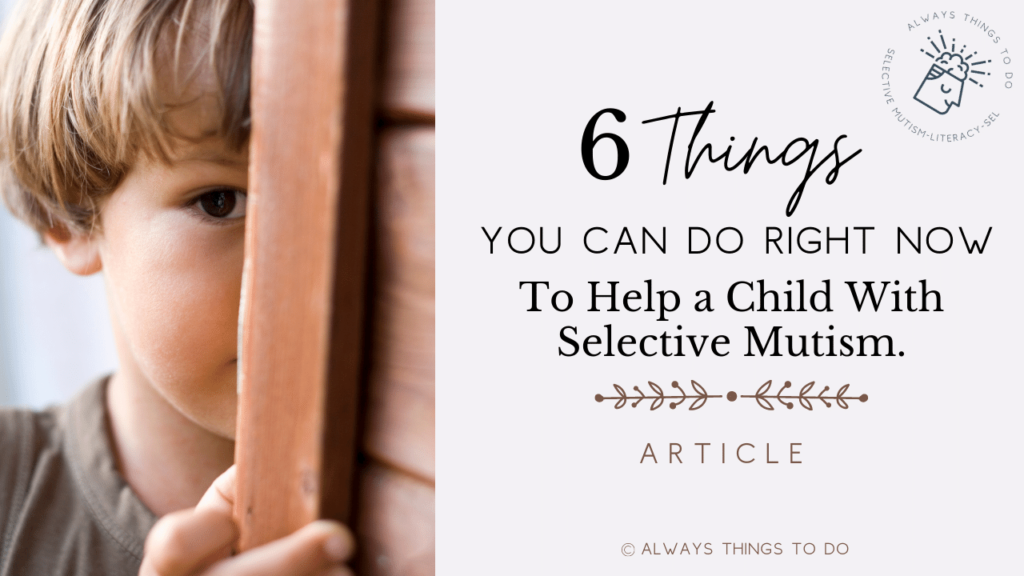
If you liked the information in this post, make sure you explore other posts about selective mutism:
- 7 Must-Do Things For A Parent of A Child With Selective Mutism: Actionable Tips and Resources to Consider.
- 6 Things You Can Do Right Now To Help Your Child With Selective Mutism.
- “What Is Selective Mutism?”
- “Selective Mutism: How To Beat Crisis, Screaming, and Fear.”
- Diagnosis of Selective Mutism: Simple Parent Guide and Steps to Take.
- What Are The Causes of Selective Mutism?
- Is Selective Mutism a Disability?
- How Do You Treat Selective Mutism?
- 70 Selective Mutsim Symptoms & 3 Diagnostic Criteria.
- Selective Mutism Myths: Most Common Concerns Addressed.
- Selective Mutism Classroom Accommodations: What You Need To Know About 504 and IEP.
Check out the expanding library of tools. Go to the selective mutism page and scroll to the bottom section, “Latest Projects.”
Connect with me on social media @alwaysthingstodo.

